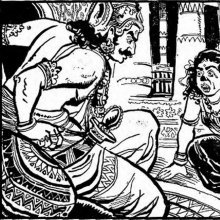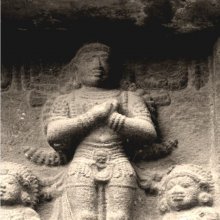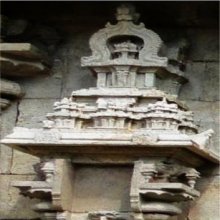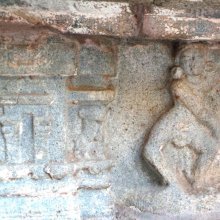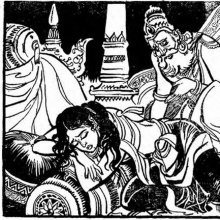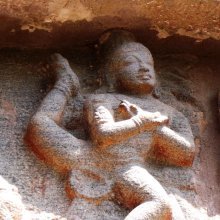Separation, Separateness, Separate, Separated: 5 definitions
Introduction:
Separation means something in Hinduism, Sanskrit, Jainism, Prakrit. If you want to know the exact meaning, history, etymology or English translation of this term then check out the descriptions on this page. Add your comment or reference to a book if you want to contribute to this summary article.
Images (photo gallery)
(+49 more images available)
In Hinduism
Natyashastra (theatrics and dramaturgy)
Source: Shodhganga: Elements of Art and Architecture in the Trtiyakhanda of the Visnudharmottarapurana (natya)1) Separation (expression) is associated with Mandālasa: one of the nine kinds of śayyāsthāna or “lying down postures” (in Indian Dramas), as conveyed through Āṅgikābhinaya: one of the four divisions of Abhinaya or “ways to convey or represent one’s emotion to others”, according to the Nāṭyaśāstra and the Viṣṇudharmottarapurāṇa, an ancient Sanskrit text which (being encyclopedic in nature) deals with a variety of cultural topics such as arts, architecture, music, grammar and astronomy.— The word mandālasa is the amalgamation of two words viz., manda i.e., slow and ālasa i.e., lazyness. To show worry, sadness and separation as well as excitement, the actor should stretch one leg and sit on other and this position is called mandālasa posture.
2) Love in Separation is denoted by the Sanskrit term Saṃbhoga and refers to one of the two types of Rati (Erotic Emotion), according to the Viṣṇudharmottarapurāṇa.—Śṛṇgāra or the sentiment of love is very important in kāvya specially in dramas. Rati i.e erotic emotion is the sthāyībhāva or permanent feeling of śṛṇgāra. Śyāma i.e dark blue is the colour of this sentiment. Viṣṇu is the God of this sentiment. It is of two kinds viz., saṃbhoga i.e., love in union and viraha i.e., love in separation. The Nāṭyaśāstra also admits it in the same spirit.

Natyashastra (नाट्यशास्त्र, nāṭyaśāstra) refers to both the ancient Indian tradition (shastra) of performing arts, (natya—theatrics, drama, dance, music), as well as the name of a Sanskrit work dealing with these subjects. It also teaches the rules for composing Dramatic plays (nataka), construction and performance of Theater, and Poetic works (kavya).
Shilpashastra (iconography)
Source: Shodhganga: Elements of Art and Architecture in the Trtiyakhanda of the Visnudharmottarapurana (shilpa)Separation is associated withe the Pathetic Sentiment (karuṇa), which refers to one of the Nine Sentiments (citrarasa) in ancient Indian Painting (citra), according to the Viṣṇudharmottarapurāṇa, an ancient Sanskrit text which (being encyclopedic in nature) deals with a variety of cultural topics such as arts, architecture, music, grammar and astronomy.—The karuṇarasa i.e., the pathetic sentiment is reflected through a Painting in which a painter creates pathos on the basis of the actions projecting begging, separation, calamity, compassion etc. [...] Thus, painting is a medium of showing the inner feelings and emotions of a painter which can strikes the inherent sentiments of connoisseur’s mind, for example: begging in the sentiment of pathos.

Shilpashastra (शिल्पशास्त्र, śilpaśāstra) represents the ancient Indian science (shastra) of creative arts (shilpa) such as sculpture, iconography and painting. Closely related to Vastushastra (architecture), they often share the same literature.
Yoga (school of philosophy)
Source: ORA: Amanaska (king of all yogas): A Critical Edition and Annotated Translation by Jason BirchSeparateness can denoted by the Sanskrit terms Pṛthak or Pṛthaktva, according to the Amanaska Yoga treatise dealing with meditation, absorption, yogic powers and liberation.—Accordingly, as Īśvara says to Vāmadeva: “[...] [Now], I shall define the nature of that highest, mind-free absorption which arises for those devoted to constant practice. [...] Just as ghee which has dissolved into [another batch of] ghee, is not separate (pṛthaktva) [in any way] from [that] ghee, so the Yogin, who has dissolved into the highest reality, is not aware of separateness (pṛthak-bhāva). [...]”.

Yoga is originally considered a branch of Hindu philosophy (astika), but both ancient and modern Yoga combine the physical, mental and spiritual. Yoga teaches various physical techniques also known as āsanas (postures), used for various purposes (eg., meditation, contemplation, relaxation).
In Jainism
General definition (in Jainism)
Source: The University of Sydney: A study of the Twelve Reflections(The soul and body are) Separate, as discussed in Bhūdhardās’s composition dealing with the twelve reflections (bhāvanā or anuprekṣā), also found in the Tattvārtha-sūtra.—Accordingly, “[...] [the soul is solitary]—You came here alone you will die alone. The soul has neither friend nor relative. (4) [soul and body are separate]—Your body is not your own—how can you call it yours? You think you see home and wealth but they really belong to another. (5) [the body is foul]—A shawl of flesh covers the body of a scavenger of a beggar. Everyone in the world is the same inside yet we feel no revulsion. (6) [...]”.
Source: ORA: Amanaska (king of all yogas): (Jainism)Separation (of the body) is denoted by the Sanskrit term Viśliṣṭa, according to verse 12.42 of Hemacandra’s Yogaśāstra.—Accordingly, “At the time of the arising of the no-mind state, the Yogin experiences the body, which is as though it does not exist, as though [it were] separated (viśliṣṭa), burned, flying up and dissolved”.

Jainism is an Indian religion of Dharma whose doctrine revolves around harmlessness (ahimsa) towards every living being. The two major branches (Digambara and Svetambara) of Jainism stimulate self-control (or, shramana, ‘self-reliance’) and spiritual development through a path of peace for the soul to progess to the ultimate goal.
See also (Relevant definitions)
Partial matches: Separation, Te.
Query error!
Full-text (+3856): Viraha, Viyoga, Viprayoga, Vishlesha, Vipralambha, Viyukta, Virahin, Viccheda, Prithaktva, Vyatireka, Prithagbhava, Vivikta, Vibhakta, Parthakya, Avacchinna, Sphotana, Vidhura, Prithak, Vibhaga, Vibhinna.
Relevant text
Search found 573 books and stories containing Separation, Separateness, Separate, Separated, The separation; (plurals include: Separations, Separatenesses, Separates, Separateds, The separations). You can also click to the full overview containing English textual excerpts. Below are direct links for the most relevant articles:
Vaisheshika-sutra with Commentary (by Nandalal Sinha)
Sūtra 7.2.8 (Non-eternal Unity and Separateness-of-one) < [Chapter 2 - Of Number, Separateness, Conjunction, etc.]
Sūtra 7.2.2 (Proof of Separateness) < [Chapter 2 - Of Number, Separateness, Conjunction, etc.]
Sūtra 7.2.3 (Unity and Separateness do not exist in Unity and Separateness) < [Chapter 2 - Of Number, Separateness, Conjunction, etc.]
World Journal of Pharmaceutical Research
Review article on high- performance liquid chromatography (hplc) < [2023: Volume 12, December special issue 22]
Ion exchange chromatography and its applications < [2021: Volume 10, July issue 8]
Advancements in HPLC Techniques for Pharmaceutical Analysis < [2023: Volume 12, November issue 19]
Brahma Sutras (Shankaracharya) (by George Thibaut)
II, 3, 26 < [Second Adhyāya, Third Pāda]
II, 2, 17 < [Second Adhyāya, Second Pāda]
III, 3, 36 < [Third Adhyāya, Third Pāda]
The Plays of Arthur Miller < [July – September, 1987]
Emotional Relationship Between Man and His < [July – September, 2006]
The Case for Karnataka < [August 1938]
Philosophy of Charaka-samhita (by Asokan. G)
Inherence (samavāya) [in Charaka philosophy] < [Chapter 2 - Fundamental Categories]
General attributes (sāmānya-guṇas) < [Chapter 2 - Fundamental Categories]
Enumeration of attributes (guṇa) < [Chapter 2 - Fundamental Categories]
Nyaya-Vaisheshika categories (Study) (by Diptimani Goswami)
Qualities (7): Pṛthaktva (Distinctness) < [Chapter 4 - Quality and Action]
Saṃyoga (Conjunction) < [Chapter 6 - Nyāya-Vaiśeṣika theory of Relation]
Reality of Relation < [Chapter 6 - Nyāya-Vaiśeṣika theory of Relation]
Related products
(+15 more products available)
